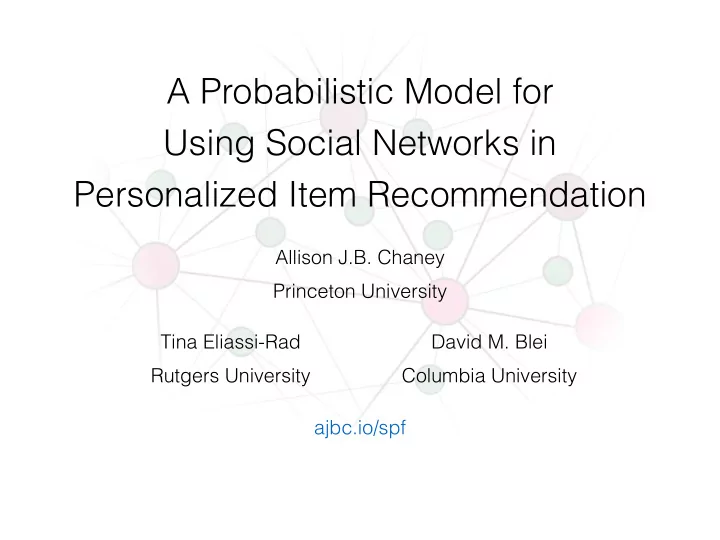

A Probabilistic Model for Using Social Networks in Personalized Item Recommendation Allison J.B. Chaney Princeton University Tina Eliassi-Rad David M. Blei Rutgers University Columbia University ajbc.io/spf
Personalized Item Recommendation Anna Karenina Winter’s Tale East of Eden ???
Matrix Factorization K # items K # users ≈ latent item attributes latent user preferences
Including Social Networks ?
Including Social Networks • Matches our intuition
Including Social Networks • Matches our intuition • Introduces explainable serendipity
Including Social Networks • Matches our intuition • Introduces explainable serendipity • Improves performance
Including Social Networks • Matches our intuition • Introduces explainable serendipity • Improves performance • Helps us learn about user behavior
An Example Etsy User
An Example Etsy User
An Example Etsy User
An Example Etsy User
An Example Etsy User
An Example Etsy User
An Example Etsy User
An Example Etsy User
An Example Etsy User
An Example Etsy User
An Example Etsy User
An Example Etsy User
An Example Etsy User
An Example Etsy User
An Example Etsy User
observed data learned parameters inference ratings item attributes algorithm user preferences network user influence model assumptions recommendations
Matrix Factorization
Matrix Factorization observed ratings
Matrix Factorization Item attributes observed ratings User preferences
Social Poisson Factorization
Social Poisson Factorization Item attributes User influence User preferences
0 1 X @ θ > r ui | r � u,i ∼ Poisson u β i + τ uv r vi A v 2 N ( u )
Posterior Inference: How do we go from a generative model to finding the values of the variables that best fit our data?
Posterior Distribution easy to compute latent model parameters p ( β , θ , τ , R , N | µ ) p ( β , θ , τ | R , N , µ ) = R R R τ p ( β , θ , τ , R , N | µ ) β θ observed data intractable model hyperparameters
Mean Field Variational Inference intractable posterior
Mean Field Variational Inference easy to compute intractable posterior approximation
Recommendation X E [ r ui ] = E [ θ u ] > E [ β i ] + E [ τ uv ] r vi v 2 N ( u )
Data source # users # items % ratings % edges Ciao 7,000 98,000 0.038% 0.103% Epinions 39,000 131,000 0.012% 0.011% Flixster 132,000 42,000 0.122% 0.006% Douban 129,000 57,000 0.221% 0.016% Social Reader 122,000 6,000 0.065% 0.001% Etsy 40,000 5,202,000 0.009% 0.300% etsy.com and librec.net/datasets.html
Existing Methods for Including Social Networks Ma et al., SoRec: Social Recommendation Using Probabilistic Matrix SoRec Factorization, SIGIR 2008. Ma et al., Learning to Recommend with Social Trust Ensemble, RSTE SIGIR 2009. Jamali and Ester, A Matrix Factorization Technique with Trust SocialMF Propagation for Recommendation in Social Networks, RecSys 2010. TrustMF Yang et al., Social Collaborative Filtering by Trust, IJCAI 2013. Guo et al., TrustSVD: Collaborative Filtering with Both the Explicit TrustSVD and Implicit Influence of User Trust and of Item Ratings, AAAI 2015. librec.net
Evaluation on held-out data N 1 [ rec n ∈ H ] 1 X X CRR ( user ) = = rank ( i ) n n =1 i ∈ H CRR ( user ) NCRR ( user ) = ideal CRR ( user )
NCRR 0.00 0.05 0.10 0.15 0.00 0.01 0.02 0.03 0.04 SF (our method) SPF (our method) SPF (our method) SF (our method) TrustMF Popularity PF PF SocialMF RSTE Ciao Etsy TrustSVD TrustSVD PMF SocialMF Popularity SoRec SoRec PMF TrustMF 0.00 0.05 0.10 0.15 0.20 0.00 0.05 0.10 0.15 0.20 Results SPF (our method) SPF (our method) SF (our method) Popularity PF PF Popularity SF (our method) Douban Flixster RSTE PMF SocialMF RSTE SoRec TrustMF TrustMF SoRec PMF SocialMF TrustSVD TrustSVD 0.00 0.02 0.04 0.06 0.0 0.1 0.2 0.3 SPF (our method) SPF (our method) SF (our method) SF (our method) Popularity PF Social Reader PF TrustMF Epinions TrustMF TrustSVD PMF PMF SocialMF RSTE SoRec Popularity RSTE SocialMF SoRec
Summary • SPF performs better than comparison models • SPF is interpretable and has explainable serendipity • SPF scales well to large data • Source code available at ajbc.io/spf
Thank you! Questions and suggestions welcome. Thank you to Blei Lab colleagues and Guibing Guo (LibRec creator) ajbc.io/spf
Recommend
More recommend